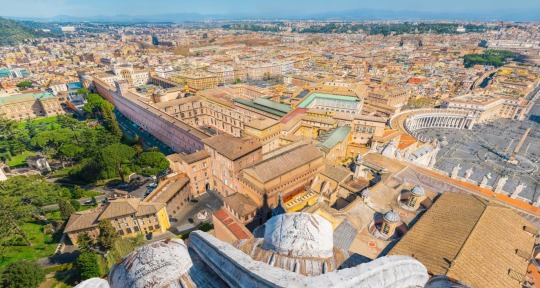#st. peter's square
Explore tagged Tumblr posts
Text

Vatican City 1880
#vatican city#1880s#europe#history#vintage#photography#pics#architecture#art#19th century#places#city state#microstate#vatican#rome#italy#pope#St. Peter's Square#St. Peter's Basilica#catholic#panorama#laundry#everyday life
121 notes
·
View notes
Photo

Leonard Freed. St. Peter's Square, Rome. 1958
I Am Collective Memories • Follow me, — says Visual Ratatosk
#BW#Black and White#Preto e Branco#Noir et Blanc#黒と白#Schwarzweiß#retro#vintage#Leonard Freed#St. Peter's Square#Rome#Italy#1958#1950s#50s#winter#l'hiver#inverno#冬#ウィンター#雪#snow#nieger#Schnee#neve#frio#resfriado#street photography#Photographie de rue#Strassenfotografie
165 notes
·
View notes
Text

St. Peter's Square and market hall in Clermont-Ferrand, Auvergne region of central France
French vintage postcard
#historic#region#photography#vintage#sepia#france#central#photo#st. peter's square#briefkaart#peter#french#ansichtskarte#postcard#clermont#auvergne#clermont-ferrand#hall#postkarte#postkaart#carte postale#market#ephemera#ferrand#square#postal#tarjeta
1 note
·
View note
Text
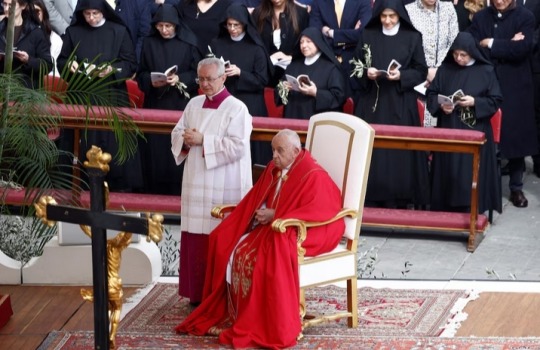
Pope Francis attends the Palm Sunday Mass in Saint Peter's Square at the Vatican, March 24, 2024. REUTERS / Guglielmo Mangiapane

March 24 (Reuters) — Pope Francis at the last minute skipped reading his homily during a Palm Sunday Mass for tens of thousands of people in St. Peter's Square but continued presiding at the service, read his noon prayer and was driven around the crowd in a popemobile.
In recent weeks, the 87-year-old pope has been suffering on and off from bronchitis and influenza and has delegated an aide to read his addresses for him, but on Sunday, his prepared text was not read at all.
It is very unusual for a pope to totally skip a homily at a major event such as Palm Sunday, which marks the start of Holy Week, a busy period leading to Easter.
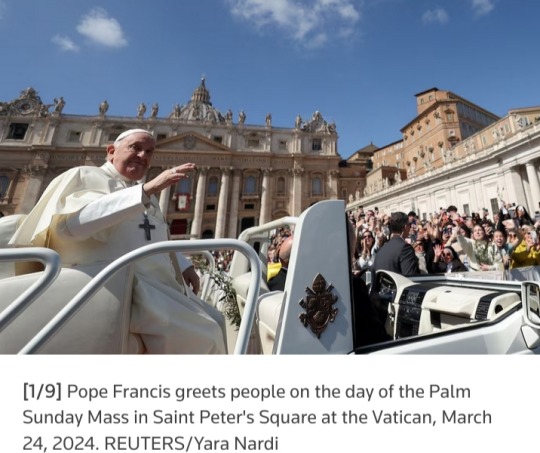
The Vatican gave no immediate explanation for why the pope skipped the homily.
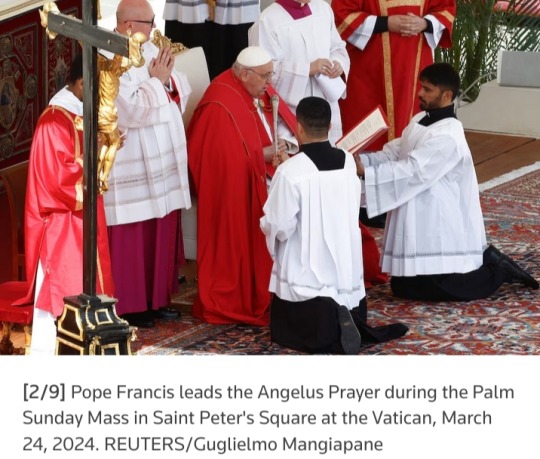

Vatican Television coverage showed only the crowd for a few minutes, instead of a close-up of the pope.
An announcer on Vatican Radio then said the pope had decided to not read the homily.
The pope, dressed in red vestments, continued presiding, reading parts of the Mass.
Cardinals, priests and bishops took part in the service that commemorates what the Bible says was Jesus' entry into Jerusalem days before he was betrayed, put on trial and executed by crucifixion.
The clerics, along with participants in a crowd estimated by Vatican police at about 60,000 people, held palm fronds and olive branches at the service.
Francis has a knee ailment, and for more than a year, he has presided at Masses while sitting near the altar while a cardinal acts as the main celebrant.
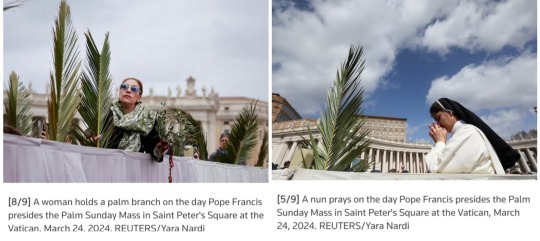
After the Mass, Francis delivered his weekly Sunday Angelus message and blessing from the altar and not from the window of the Apostolic Palace overlooking the square. That is not unusual on major occasions.

In the prayer, he condemned the shooting attack that killed at least 133 people at a concert hall near Moscow as a vile and inhuman act that offends God.
He again asked for prayers for all those suffering from wars, mentioning Ukraine and Gaza.
At the end of the service, Francis was driven around the square in an open-top vehicle.
He waved and smiled at people in the crowd and did not appear to be any difficulty.
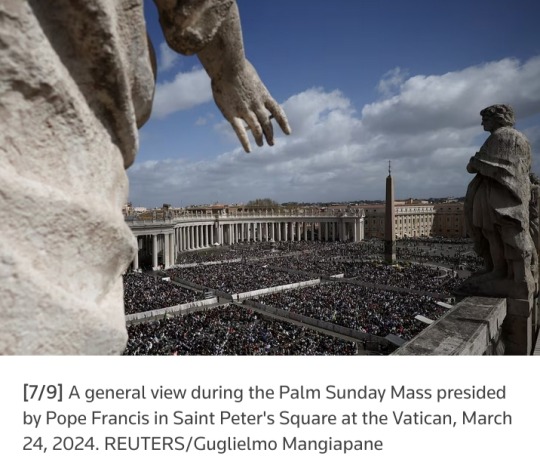
#Pope Francis#Vatican#Palm Sunday#Palm Sunday Mass#Holy Week#palm branches#St. Peter's Square#Vatican Television#Vatican Radio#olive branches#Sunday Angelus#Apostolic Palace
0 notes
Text




Andy Warhol meeting Pope John Paul II at St. Peter's Square in Vatican City on April 2, 1980.
Photos by Lionello Fabbri
168 notes
·
View notes
Text
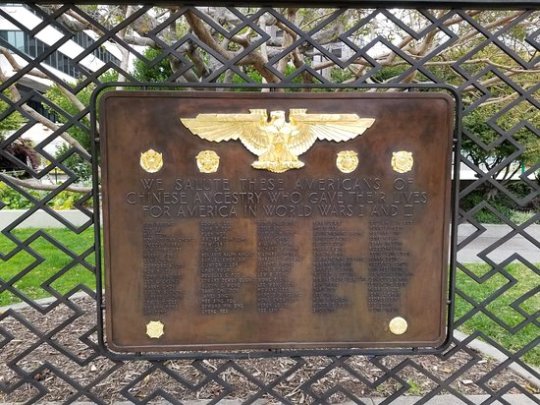
The then newly-restored plaque in St. Mary’s Square honoring the “Americans of Chinese Ancestry” who gave their lives for America in its world wars, November 10, 2018. Photograph by Doug Chan.
The Last Full Measure: St. Mary’s Square Monument to the Fallen of Chinese America
In his book San Francisco Chinatown: A Guide to its History & Architecture, historian Philip P. Choy, shared his observations about the monuments in St. Mary’s Square as follows:
“Across from the statue of Dr. Sun Yat-sen is a less imposing but more significant monument, with 97 names of Chinese American soldiers of our community, who made the supreme sacrifice in World War I and II. Every year on Veterans Day, the Cathay Post No. 384 and the VFW Chinatown Post march to the square to honor those who died for us, that they never be forgotten. This commemorative plaque and day of remembrance are more symbolic of Chinese America than Sun Yat-sen’s statue and the “Ten Ten” celebration.”
During the Second World War, thousands of young men and women enlisted or were drafted from Chinatowns, Japantowns (and concentration camps), Manilatowns, and other small communities across the country.
According to the U.S. Department of Veteran Affairs and researchers at the Oakland Museum, 13,499 Chinese American men fought in the armed forces. (Community estimates range as high as 20,000.) Approximately 75 percent served in the US Army, with ground units such as the 3rd and 4th Infantry Divisions in Europe and the 6th, 32nd and 77th Infantry Divisions in the Pacific. A quarter of the total Chinese American personnel under arms served in the Navy. Still others served in specialized units, such as the all-Chinese American 1157th Signal Corps -- part of 14th Air Service Group that would join the fight against Imperial Japan in the China Burma India theatre of operations.
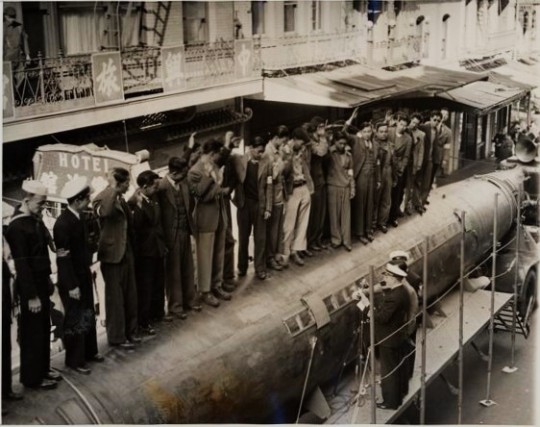
Group of Chinese recruits for the U. S. Navy taking their oath on top of a captured Japanese submarine, on Navy Day in San Francisco Chinatown, October 27, 1942. Associated Press photographer unknown (from the collection of the San Francisco Public Library). As written on the verso: ""A two-man Jap submarine, captured after the sneak attack on Pearl Harbor, T.H. [Territory of Hawaii], began its nation-wide tour in San Francisco Oct. 27. In Chinatown, Chinese recruits for the U.S. Navy lined up on the vessel and took their oath. It was part of Navy Day ceremonies."
The Chinese American men who served in the armed forces during WW II comprised 20 percent of all such men in the continental U.S. As historian Iris Chang would write decades later, “ethnic Chinese men gave their lives disproportionate to their presence in the country.”
As in many cities, the public spaces in San Francisco had included memorials to the fallen in America’s wars. On Memorial Day on May 30, 1919, city officials and thousands of spectators dedicated a 15-acre plot as the “Grove of Heroes,” in remembrance of the US dead and wounded in the First World War. In 1930, a sculpture originally created by M. Earl Cummings for the Pan Pacific International Exposition was acquired and installed in the meadow adjacent to the grove. The bronze figure holding a laurel wreath became known as the “Doughboy Statue,” and it is readily noticeable from the park’s John F. Kennedy drive and promenade. On Armistice Day (now known as Veterans Day), November 13, 1932, public officials assembled again to dedicate an 18-ton granite boulder (reportedly quarried from Twin Peaks) to commemorate US war dead. The monument, which was sponsored by the Native Sons of the Golden West, was inscribed with the names of 748 men and 13 women, all local soldiers and volunteers who died during the Great War.
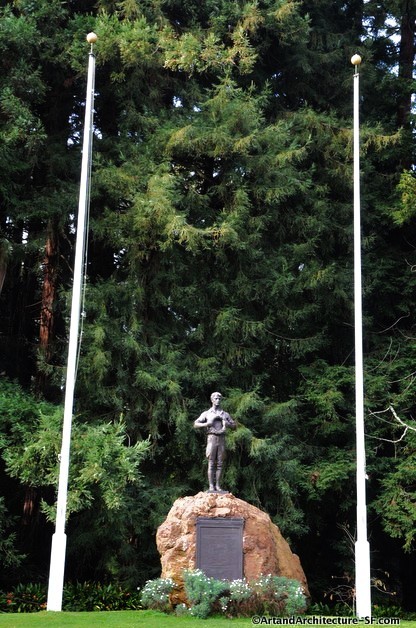
The Doughboy Statue in the “Grove of Heroes” in San Francisco's Golden Gate Park. The plaque, sponsored by the Native Sons of the Golden West and inscribed with the names of US dead in two world wars, omits the names of non-white military personnel killed in the line of duty.
Although Chinese Americans had served and died in WW I, no Chinese names had ever been inscribed in any of San Francisco’s war memorial monuments from that era. Their omission was hardly surprising. The Native Sons of the Golden West had been founded in July 1875 as a fraternal organization "embracing only the sons of those sturdy pioneers who arrived on this coast prior to the admission of California as a state." In the 1920s, the Native Sons adopted a white nativist stance on public policy issues. President William P. Canbu of the Native Sons wrote that “California was given by God to a white people, and with God’s strength we want to keep it as He gave it to us.” The Native Sons openly opposed Chinese, Mexican, and Japanese immigration. At the outset of the Second World War, the organization waged an unsuccessful legal battle for Japanese Americans to be disenfranchised.
The size of the returning cohort of Chinese American men (and the few women) from the Second World War had been unprecedented, and they produced a transformative generation of determined civic activists in the postwar era. As was the case with many other communities of color in the country, Chinese Americans had to struggle for acceptance and civil rights. Community activists such as John C. Young, a retired colonel from the United States Army and World War II veteran, made it their mission to join the struggle for Chinese Americans’ civil rights and participation in mainstream society. Young’s family led that effort by example as one of the first Chinese families to buy a home in defiance of racially-restrictive covenants against homeownership in San Francisco’s Richmond District (See the story here: https://www.outsidelands.org/chinese-in-the-richmond-alfred-john-young-and-connie-young-yu.php)
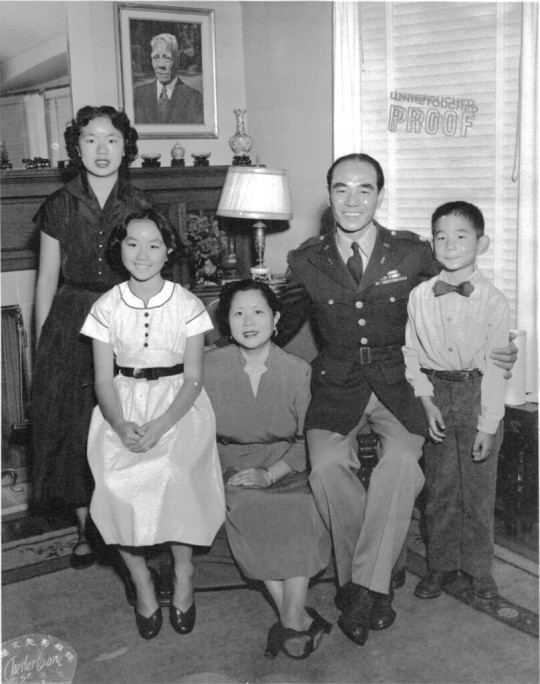
Left to right: Janey Young Cheu, Connie Young Yu, Mary Lee Young, Lt. Col. John C. Young, and Alfred John Young in the Young family house at 674 37th Avenue, circa 1952. (Courtesy of Al Young)
With the onset of the Cold War and actual armed conflict on the Korean peninsula, Chinese American leaders sensed that the path toward progress and acceptance of Chinese Americans had been jeopardized by the People’s Republic of China’s deploying troops to support North Korea’s military against UN forces.
As a commander of the American Legion Post #384 (Cathay Post), John Young and his fellow veterans spearheaded a proposal to erect a war memorial to the fallen Chinese American Veterans of World War I and World War II.
In 1951, the same year in which the Native Sons added the names of 16 white members who had died in World War II to the plaque on the rock pedestal of the Doughboy Statue, Chinese American veterans’ proposal to honor their fallen comrades in Chinatown gained acceptance.
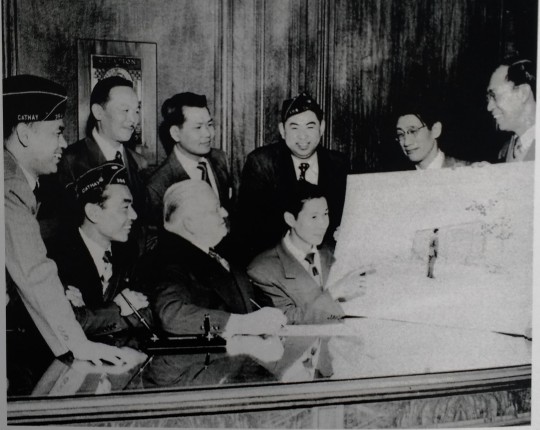
Members of the VFW Chinatown post and Cathay Post no. 384 of the American Legion huddle and review conceptual drawings for a St. Mary’s Square monument with San Francisco Mayor Elmer Robinson in the Mayor’s office in City Hall, c. 1951. Standing (left to right): Lim P. Lee, Peter H. Wong (unidentified veteran), Shaw Pange, Charles Leong, and Joseph Quan. Sitting: John C. Young, Mayor Elmer Robinson, and James Hall. Photographer unknown (from the collection of the late Col. John C. Young and his daughter Connie Young Yu).
Before 1951, a large and dramatic stainless steel statue of Dr. Sun Yat-sen, designed local sculptor Benny Bufano, represented the principal statuary in St. Mary's Square.
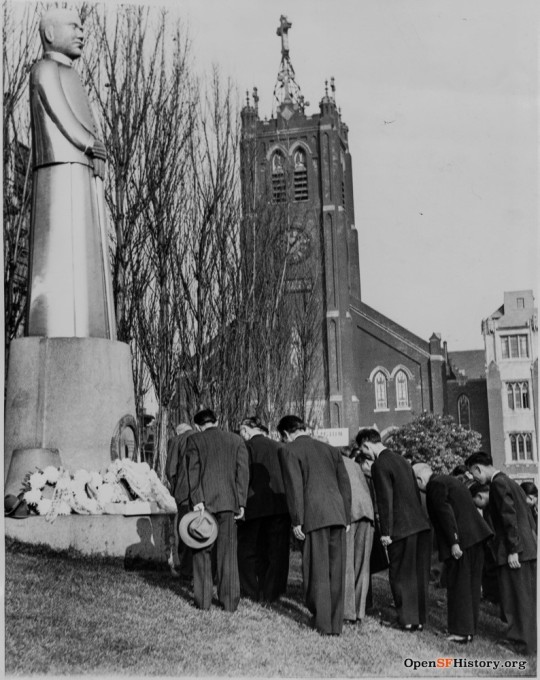
St. Mary's Square Nov 12, 1943. In this view of St. Mary's Square, looking north toward Old St. Mary's Church, members of San Francisco’s Chinese community bow before the statue of Sun Yat Sen on the occasion of Dr. Sun’s birthday. Among those attending the ceremony was Tse Kiong Sun, grandson of Sun Yat Sen. Photographer unknown (Courtesy of a private collector).
According to historian Phil Choy, the statue had been commissioned by the Chinese Six Companies to commemorate October 10, 1911, the day Dr. Sun's revolutionary party overthrew the Manchu government and established the Republic of China. As Choy wrote in 2012:
“For almost a century, October 10th, known by the Chinese as “Ten Ten,” was a major day of celebration in the community. Banners stretched across Grant Avenue. Organized by the Chinese Six Companies, drum & bugle corps and pupils from every Chinese language school dutifully paraded through the streets. Today the celebration no longer has 100% community support. Members of the Chinese Six Companies are divided; some still embrace the Kuomintang (KMT) Party of the former Republic of China (now the Taiwanese Government), while others support the People’s Republic of China.”
The efforts by the Chinese community’s veterans and supporters to honor the fallen of two world wars culminated in 1951 with the installation of the memorial plaque still seen today in St. Mary's Square. (A recounting of the memorial's dedication and other recollections by the daughter of one of the leaders in the effort to establish the monument, historian Connie Young Yu, may be heard here. (https://chiamgi.substack.com/p/col-john-c-young-profile?triedRedirect=true)
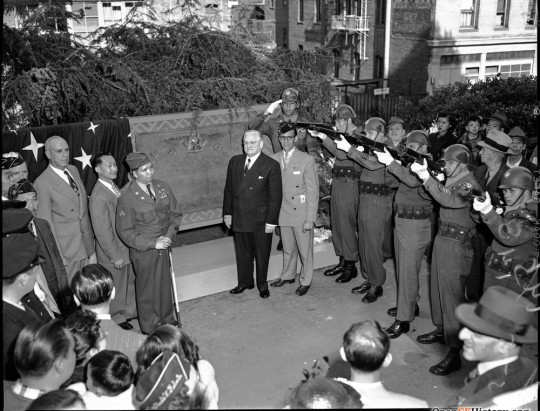
“Soldiers firing salute at dedication of memorial to deceased Chinese-American veterans at St. Mary's Square,” May 28, 1951. Mayor Elmer Robinson stands at center in dark suit. Photographer Unknown (Examiner Negative Collection / courtesy of a private collector)
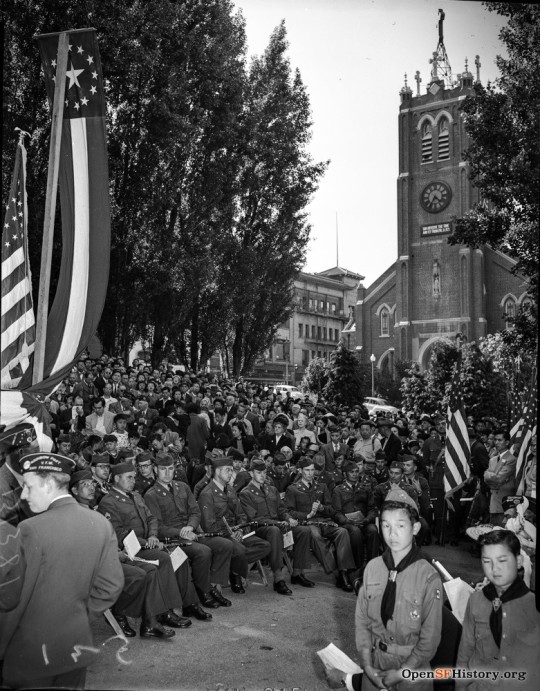
A large crowd attended the dedication ceremonies for the Chinese veterans memorial at St Mary’s Square on May 28, 1951. An Army band is seated with musical instruments, and members of the Chinatown Boy Scouts troop appear in the right foreground. Photographer unknown (form a private collection).
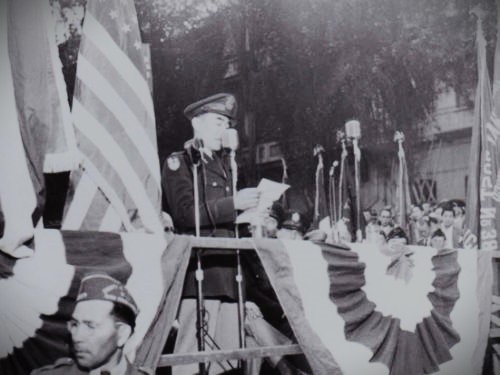
Civic leader and president of the Wing Nien Soy Sauce Co. Col. John C. Young (ret.) speaks to the crowd assembled on May 28, 1951, for the dedication of the memorial to Chinese American service personnel killed during the First and Second World Wars. His speech to the crowd occurred in the presence of his former commanding officer, General Albert Wedemeyer, under whom Young served as a heavy weapons officer in the China-Burma-India theater of operations.
If the irony of Chinese Americans' entering the US armed forces during wartime was apparent, it was never expressed publicly by those who had served honorably. Native-born, as well immigrants ineligible to naturalize as citizens by punitive immigration laws, had answered the call to service for an America that had, for most of the previous century, robbed, murdered, burned, lynched, taxed, and excluded the pioneer generations, while building much of the political economy of the American West on the strength of Asian labor.
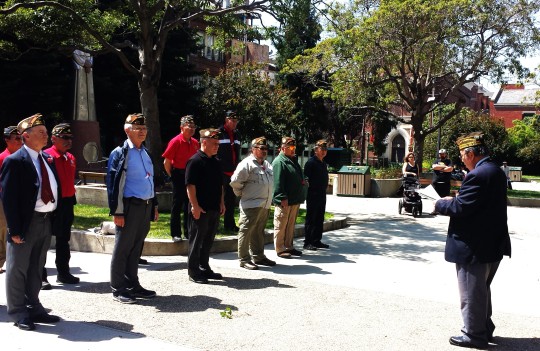

Veterans from Chinatown's American Legion Cathay Post 384 and VFW Chinatown Post 4618 assembled on Memorial Day 2016 in front of the WW I and II memorial plaque in St. Mary’s Square to commemorate the Chinese American fallen in all the nation’s conflicts and wars. Photograph by Doug Chan.
The numbers of Chinese Americans KIA and MIA from the world wars remain imprecise. The honored dead, including Medal of Honor recipient Capt. Francis B. Wai are, and will be, remembered in perpetuity for their extraordinary heroism and devotion to duty. For others, such as Lt. Kenneth Kai-Kee, the memories, grief and loss of those he left behind have already faded with the passing of family, friends, and loved ones.
The passage of time confers on community historians the duty to impart to each new generation the mission to remember the wartime sacrifices of Chinese America's sons and daughters. The debt to those who gave the last full measure of devotion must be honored in perpetuity.
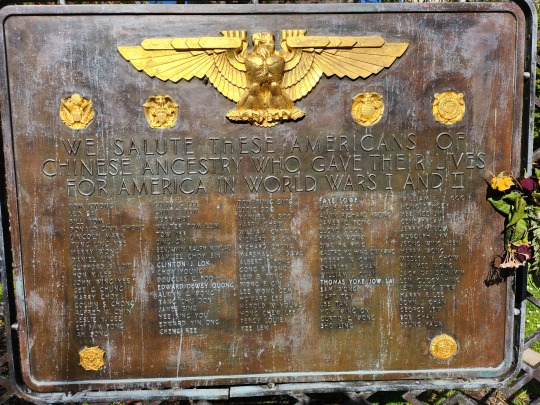
Photograph by Doug Chan.
#St. Mary's Square#Cathay Post veterans#Col. John C. Young#Francis B. Wai#Kenneth Kai-Kee#Lim P. Lee#Peter H. Wong#Shaw Pang#Charles Leong#Joseph Quan#Chinese American veterans memorial
2 notes
·
View notes
Text

Santa in St Peter's Square
1 note
·
View note
Text

I’m nominating St John the Baptist for Best Choice of Digital Streaming in a School Lobby for their excellent decision to broadcast Vatican Media’s live 24/7 coverage of the Christmas tree by the ancient obelisk monument at St Peter’s Basilica.
0 notes
Text
Are climate activists or the pope ruining Christmas in St. Peter's Square
Climate activists have launched a campaign in the northern Italian province of Trentino to prevent a 29-meter tall silver fir from being cut down to serve as a Christmas tree in St. Peter’s Square in Vatican City. The 200-year-old conifer from a forest in the Ledro Valley was supposed to end up in St. Peter’s Square to be unveiled on Dec. 9. But that is not to the liking of many people with a…
0 notes
Text
Rimini… the Miami of Europe
Rimini is a vibrant city nestled along the Adriatic coast in northern Italy that effortlessly blends the allure of sun-soaked beaches with a rich tapestry of history.
Rimini Rimini is a vibrant city nestled along the Adriatic coast in northern Italy that effortlessly blends the allure of sun-soaked beaches with a rich tapestry of history. Known for its lively atmosphere and expansive sandy shores, the Miami of Europe has long been a favourite summer destination for Italians and visitors from across Europe. But beyond its reputation as a beach paradise, the…
#Acquario di Cattolica#adventure#Arch of Augustus#Basilica di San Marino#blog#city#Diamond Wheel#Europe#Football#History#ITA#Italia in Miniatura#Italy#Palazzo Pubblico#Piazza della Liberta#Ponte di Tiberio#Rimini#Ristorante Pizzeria A&039;Mare#Roman#Roman Amphitheatre#San Marino#San Marino Cable Car#San Marino Stadium#Sicily by Car#Sistine Chapel#St Peter&039;s Basilica#St Peter&039;s Basilica Dome#St Peters Square#Three Towers of San Marino#Tourist Information
1 note
·
View note
Text

St. Peter's Square in Montmartre neighbourhood of Paris
French vintage postcard
#postal#historic#french#ansichtskarte#st. peter's#paris#sepia#montmartre#vintage#tarjeta#peter#briefkaart#photo#neighbourhood#postkaart#square#ephemera#postcard#postkarte#photography#carte postale
4 notes
·
View notes
Text
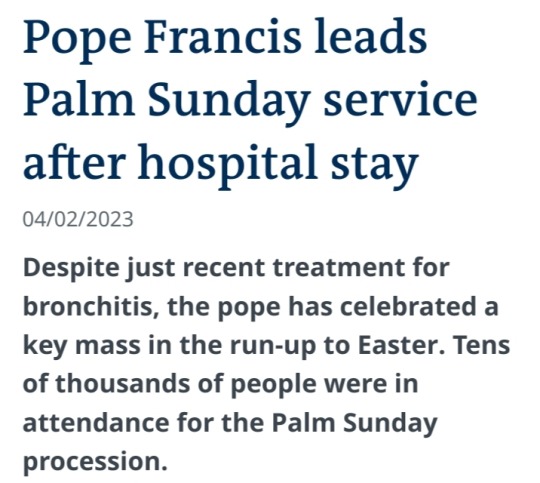
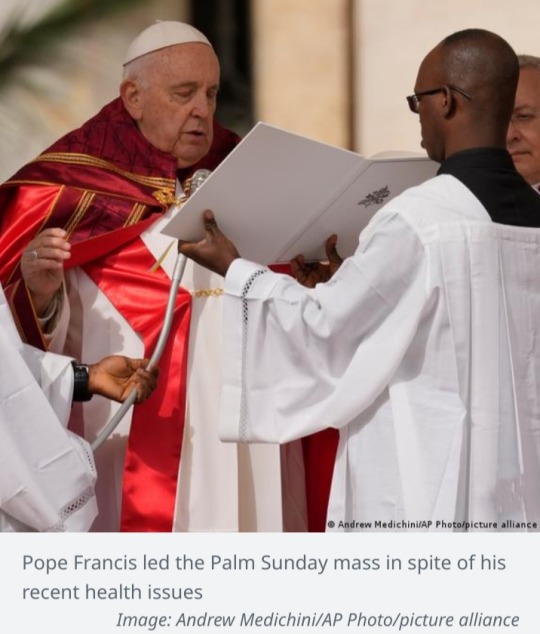
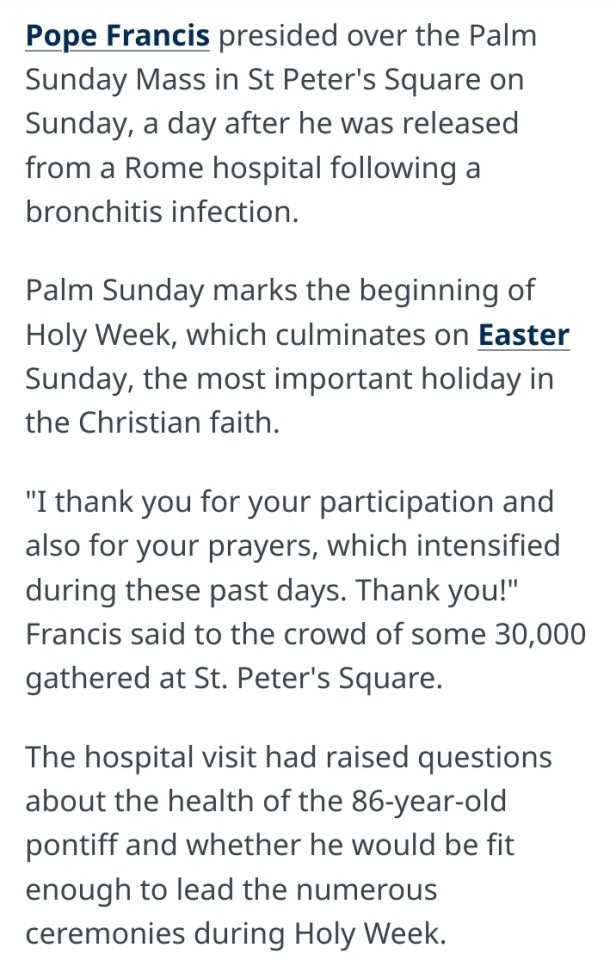
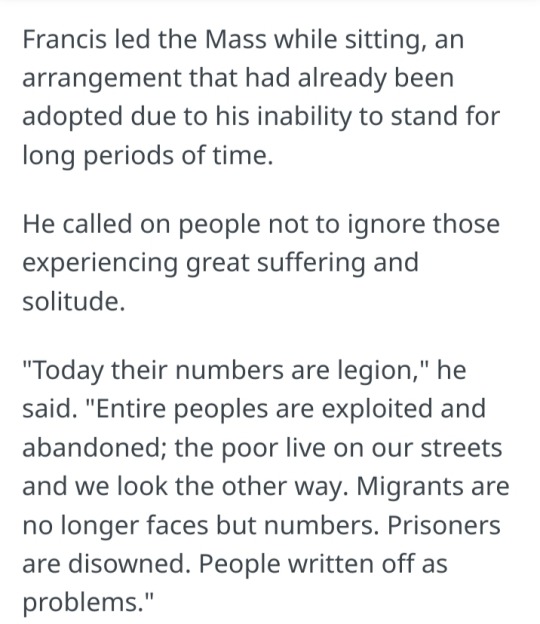

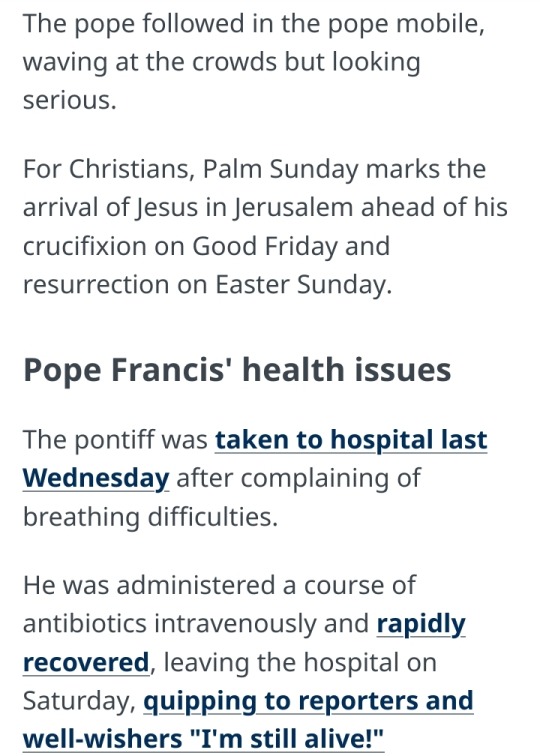


9 notes
·
View notes
Text

Emmeline Pankhurst Memorial (St Peter's Square, Manchester, 2024)
Possibly my favorite statue of all time. I've been fascinated and awed by her since I first saw her as a little girl.
#emmeline pankhurst#manchester#manchesterphotography#photography#dark academic aesthetic#st peters square#feminism#feminist photography#uk photography
1 note
·
View note
Text
St. Peter Square
Postcard from Vatican One of the two fountains in St. Peter’s Square in Vatican City, created by Carlo Maderno (1612–1614) and Gian Lorenzo Bernini (1667–1677) to add ornament to the square in front of St. Peter’s Basilica.

View On WordPress
0 notes
Text

St Peter's Square, Manchester
HP5 400
#manchester#townsquare#bee#manchesterbee#filmphotography#analogue#tourist#streetsofmanchester#hp5plus400#St Peter's Square
0 notes
